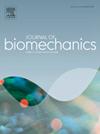On the number of steps required to measure the mean and variability of spatio-temporal parameters at preferred running speed
IF 2.4
3区 医学
Q3 BIOPHYSICS
引用次数: 0
Abstract
Preferred running speed is a relevant condition for measuring spatio-temporal parameters and their variability as it theoretically corresponds to an intensity where the energy cost, the biomechanical constraints and the pleasure are optimal. The objective of this study was to evaluate 1) the between-days reliability of spatio-temporal parameters measurements at preferred running speed and 2) the minimal number of steps required to obtain a representative measurement. Thirty-one recreational runners (age: 26 ± 5.5 years; running experience > 2 years) performed three sessions of treadmill running at preferred running speed separated by 24 h. Spatio-temporal parameters were stride, step, contact and flight times, cadence, step length, duty factor, vertical and leg stiffness. Mean, linear and non-linear measurements of spatio-temporal parameters were computed. Reliability was determined using intraclass coefficient correlation and his 95 % confidence interval lower band (95 %LB). Number of steps required for intra-session representativity were defined as the first number of steps from which all measurements are equal to the measurement at the longer time series length. For all spatio-temporal parameters, mean data showed excellent reliability (95 %LB > 0.90) but most spatio-temporal parameters linear and non-linear variability measurements showed questionable reliability (95 %LB < 0.79). The absolute speed variation at preferred running speed (minimal detectable change 0.8 km/h) may explain these results. Representative values required between 16 and 352 steps for mean value of spatio-temporal parameters, between 16 and 400 steps for linear measurements, and between 336 and 704 steps for non-linear measurements.
求助全文
约1分钟内获得全文
求助全文
来源期刊

Journal of biomechanics
生物-工程:生物医学
CiteScore
5.10
自引率
4.20%
发文量
345
审稿时长
1 months
期刊介绍:
The Journal of Biomechanics publishes reports of original and substantial findings using the principles of mechanics to explore biological problems. Analytical, as well as experimental papers may be submitted, and the journal accepts original articles, surveys and perspective articles (usually by Editorial invitation only), book reviews and letters to the Editor. The criteria for acceptance of manuscripts include excellence, novelty, significance, clarity, conciseness and interest to the readership.
Papers published in the journal may cover a wide range of topics in biomechanics, including, but not limited to:
-Fundamental Topics - Biomechanics of the musculoskeletal, cardiovascular, and respiratory systems, mechanics of hard and soft tissues, biofluid mechanics, mechanics of prostheses and implant-tissue interfaces, mechanics of cells.
-Cardiovascular and Respiratory Biomechanics - Mechanics of blood-flow, air-flow, mechanics of the soft tissues, flow-tissue or flow-prosthesis interactions.
-Cell Biomechanics - Biomechanic analyses of cells, membranes and sub-cellular structures; the relationship of the mechanical environment to cell and tissue response.
-Dental Biomechanics - Design and analysis of dental tissues and prostheses, mechanics of chewing.
-Functional Tissue Engineering - The role of biomechanical factors in engineered tissue replacements and regenerative medicine.
-Injury Biomechanics - Mechanics of impact and trauma, dynamics of man-machine interaction.
-Molecular Biomechanics - Mechanical analyses of biomolecules.
-Orthopedic Biomechanics - Mechanics of fracture and fracture fixation, mechanics of implants and implant fixation, mechanics of bones and joints, wear of natural and artificial joints.
-Rehabilitation Biomechanics - Analyses of gait, mechanics of prosthetics and orthotics.
-Sports Biomechanics - Mechanical analyses of sports performance.
 求助内容:
求助内容: 应助结果提醒方式:
应助结果提醒方式:


